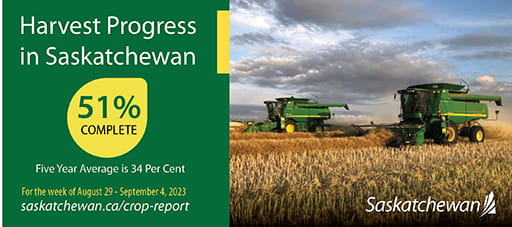Released on September 7, 2023
Producers have crossed the half-way point of harvest this week at 51 per cent complete. This is up from 33 per cent last week, ahead of the five-year average (2018-2022) of 34 per cent and the 10-year (2013-2022) of 33 per cent.
The southwest continues to lead harvest progress at 81 per cent complete, this includes an estimated three per cent of all crops being used as a feed source. Harvest in the west central region is also rapidly advancing with 60 per cent of the crop in the bin. The southeast is close to the half-way point at 49 per cent complete. The northwest has made significant progress this week and is now 21 per cent complete.
Harvest progress was made in all cropss this week. Harvesting of fall cereals are now completed, with lentils 91 per cent and peas 92 per cent complete. Significant progress was also made in all spring cereals, with durum leading at 73 per cent harvested. This is followed by barley at 68 per cent, spring wheat at 50 per cent and oats at 36 per cent. Seventy per cent of triticale has been harvested, with 61 per cent of the crop being used for feed. Mustard continues to lead the progress in oilseeds, with 68 per cent of the crop in the bin, followed by canola at 23 per cent, flax at 14 per cent, and soybeans at 31 per cent. Canaryseed and chickpeas are near the half-way mark, with 45 per cent and 51 per cent harvested respectfully.

The diverse growing conditions across the province this year are apparent as producers are seeing varying yields for all crop types. The drought conditions the southwest have led to yield averages well below the provincial averages. Meanwhile, the moisture received in the northeast has led to above average yields. Hard Red Spring Wheat is provincially estimated at 42 bu/ac, durum yields are estimated at 23 bu/ac, and barley is estimated at 53 bu/ac. Canola is estimated to yield 31 bu/ac, while mustard is estimated at 599 lbs/ac. Lentils are estimated to yield 1,058 lbs/ac, chickpeas at 1,071 lbs/ac, and peas at 30 bu/ac.
Pockets of moisture moved across the province this week, with the Kelliher area receiving the most rain at 44 mm. Regionally, the southeast received the most moisture, with the Corning area reporting 41 mm of rainfall. Cropland topsoil moisture remains relatively unchanged, with 36 per cent having adequate moisture, 39 per cent is short and 25 per cent is very short. Hay and pasture land topsoil moisture increased this week, with 29 per cent having adequate moisture, 40 per cent is short and 31 per cent is very short.
Grasshoppers remain the primary concern for producers this week, while gophers remain an issue and waterfowl have returned to the northern fields. Regions that received rain are concerned with sooty moulds resulting in downgrading of standing crops. Producers are busy swathing and combining, while also hauling feed and water for cattle. Some producers have brought cattle home for the winter and have begun feeding them.
Harvest is a very busy and stressful time for producers. They are reminded to take safety precautions in all the work they do. This includes having fire mitigation resources at the ready and taking precautions when working around powerlines. The Farm Stress Line is available to provide support to producers toll free at 1-800-667-4442. The public is reminded to take extra caution, time and space when encountering machinery on the roads.
A complete, printable version of the Crop Report is available online at https://www.saskatchewan.ca/crop-report.
Follow the 2023 Crop Report on Twitter at @SKAgriculture.
-30-
For more information, contact:
Mackenzie HladunAgriculture
Moose Jaw
Phone: 306-694-3592
Email: mackenzie.hladun@gov.sk.ca
